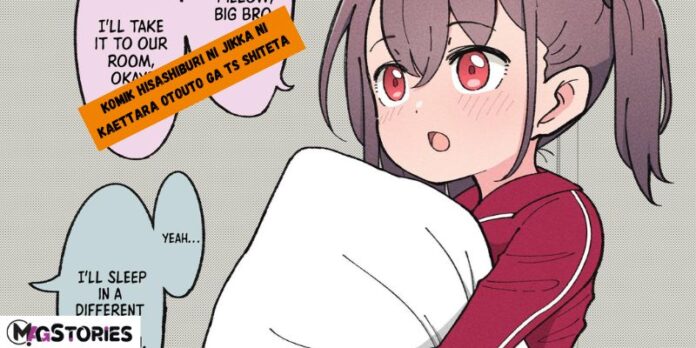Understanding the Title
Breaking Down The Phrase “komik hisashiburi ni jikka ni kaettara otouto ga ts shiteta”
Komik
“Komik” suggests a feeling of nostalgia or longing, akin to the English word “miss.
Hisashiburi
“Hisashiburi” means “long time no see,” conveying a sense of reunion after a prolonged separation.
Ni jikka ni kaettara
“Ni jikka ni kaettara” translates to “when I returned home after a while,” indicating a return to one’s roots or familiar surroundings.
otouto ga ts shiteta
“Otouto ga ts shiteta” means the younger brother who was waiting, for him. So, expression implies a brother who silently awaits homecoming in the end and hence making family members remember, reunite, and connect.
Briefly introduce the title and its significance
Let’s begin with unraveling the sentence: Suddenly my brother called me to his room. The sentence, “When I came back after a while I saw my younger brother had grown tall,” demonstrates the momentary exuberance and transformation that are in harmony with the main idea of family in the film.
In this section, we’ll unravel the mystery behind the title “What does komik hisashiburi ni jikka ni kaettara otouto ga ts shiteta mean and an inspiring travel into the wealthy embroidered artwork of Japanese culture and the persevering control of familial bonds: a thorough analysis of the show.
Focus of the series: exploring Japanese culture, familial bonds
This segment of my paper focuses on Komik Hisashiburi Ni Jikka Ni Kaettara Otouto Ga Ts Shiteta and its significance within the story framework. Therefore, it is not only the sentence but also the Japanese culture that makes families close together.
Next thing is: if I go back home at first, the baby is already born. This saying has a lot of meaning and it is the main theme which is conveyed in each episode of the series. They are not just a pile of words, but they represent the Japanese culture, values, and the essence of the family bond.
We will have a closer look at the artworks and get to the bottom of the Japanese culture. Whether it would be the intricacy of the traditional art or the colorful palate of the Japanese cuisine, every element of the culture is explored and illustrated in a concrete way. Additionally the manga highlights that family ties are eternal and their effect transcends generations with the phrase komik hisashiburi ni jikka ni kaettara otouto ga ts shiteta.
Embarking on the Journey
Set the scene for the journey into Japanese culture
Stroll through the mystery of Japanese culture, every inch uncovering a story that I am eager to share with you. The sentence “Komik hisashiburi ni jikka ni kaettara otouto ga ts shiteta” is not just an expression but a key to all that forms Japanese unique tradition and way of life. From the busy metropolis of Tokyo to the meditative scenery of Kyoto where art and culture are intertwined to create a complete verve.
Through the path of finding the Japanese culture, you will understand that world of beautiful artworks is waiting for you. From ukiyoe prints with their subtle lines to kimono patterns with intricate designs, each item reflects the long-standing history of fine arts and the artistic talent of our ancestors. The surprising thing about those who have never experienced the art and culture connection is that they are shocked and amazed to see the artistic beauty and greatness from the art inside.
Describing the allure of Japanese artwork and its significance
What is very beautiful in Japanese art is that nature has a very intimate relationship with this art. When my mother died, and my younger brother left for college, I started to read manga again. It is clearly evident that an appreciation of nature is present in many art forms, such as in brush paintings, which depict singular landscapes, and complex decorations that feature flowers and animals. Japanese artists find themselves often captivated by the seasons, seeking to reflect the elegance of sakura in spring and the serenity of snowy scenes in winter. Through their artwork they aim to highlight the bond between people and nature.
Highlight the richness and depth of Japanese cultural heritage
One of the most remarkable traits of the Japanese culture is its amazing art history’s achievement. We are taken to that world, the world of Japanese art, through the introduction of woodblock prints- ukiyo-e, and Zen gardens that are enveloped in the peacefulness of their environment. Each of these brushes and these carvings carries their stories with them. They help us learn about different generations’ values and beliefs.
However, not only the bright side of the Japanese culture was preserved in the art; the deeply rooted values are what have made the country what it is. When he returns home, and he sees that his son has grown larger, he brings up the subject of family ties, which is an essential thing in Japanese culture. It is largely from the respect for elders to their sense of duty for the relatives that Japanese culture is formed.
Exploring Familial Bonds
Delve into the theme of familial bonds in Japanese society
The phrase Komik Hisashiburi Ni Jikka Ni Kaettara Otouto Ga Ts Shiteta summarizes what a family means to the structure and culture of Japan. In Japan the family is highly valued and is considered to be the foundation of society and individuality. “Komik hisashiburi ni jikka ni kaettara otouto ga ts shiteta” depicts the same emotions and complexities of the Japanese family relationships that describe the strong bond among the brothers.
importance of family relationships and obligations
The Japanese family is referred to as the backbone of the society. It determines individual identities and behaviour through its kinship organization. From the early years, children are taught about putting families first and adults must be respected. Family is the essence of the cultural emphasis which is essential to the feelings of the belonging and the care. In addition to this, the responsibilities of happiness are not limited solely to the relatives as they also include extended families and the ancestors who have connections to generations.
bonds are portrayed and explored in the series
The word “homecoming” might seem like just a sentence in the film “Komik Hisashiburi Ni Jikka Ni Kaettara Otouto Ga Ts Shiteta“. Nevertheless, it communicates more than that: it’s an insight into the family ties in Japanese culture. Utilizing the phrase, Komik Hisashiburi Ni Jikka Ni Kaettara Otouto Ga Ts Shiteta emphasizes the emotional bonding of family members and the sense of belonging among the Japanese family members. Through the series, the relations are treated through many ways which reflect how they are still significant in Japanese community.
The Series Overview
comprehensive overview of the series
As we walk through the chapters, we will find an abundance of artworks that will replicate the real Japanese way of life. Whether it is the vivid colors of traditional Japanese artwork or the intricate brushstrokes that depict nature, all the scenes put emphasis on the richness and the depth of creativity of Japanese masters. Through the travels, we will be able to recognize how the conventional patterns are braided with any other parts of the Japanese culture.
Summarize the key plot points, characters, and themes
To start with, we do the voice over. This simply means that when I came back home (after a while), my young brother was already there. This is a pivotal moment in the show. It expresses the return to the family after a period of their separation, which is also related to the theme of the restoration of roots that is already present in the story.
narrative arc and its impact
The series’ narrative focuses on many aspects of Japanese culture, ranging from the classic customs to the modern fashion. So when the hero of the manga returns home, he will be more conscious of the cultural tendencies that are responsible for the plot. Characters struggle with the society during the changes in which they are put through and therefore the complexities in family relations as well as the pressures that comes with them are brought to light.
Inspirational Insights
lessons learned from the series
In the course of the series, the officers stricken with adversities can only be helped by the team together. By returning home to his younger brother, it shows that family connection is the main thing which gives you the strength that you need.
Reflection of the beauty of Japanese culture
Admiring the beauty of the abovementioned culture and strength of interpersonal relations gives us a flashback about the depth of sense of komi hisashiburi ni jikka ni kaettara otouto ga ts shiteta. Japanese art is highly appreciated for its elegance and sophistication, reflecting the depth and the values of the country.
Encourage readers to delve deeper into the series
If this “Komik Hisashiburi Ni Jikka Ni Kaettara Otouto Ga Ts Shiteta” amused you, I recommend you take the following step. Try getting further into the series and conduct your own research about the Japanese culture. This is not just an offer; it’s a perfect opportunity to be a part of the Japanese traditions, customs, and values that are woven throughout the tapestry of the story.
Conclusion
To sum up, we’ll focus on the main things that have been covered in this theme. I hope this journey together into the depths of Japanese culture will lead you to realize the importance of family bonds.
This passage has enabled us find out the meaning of the phrase komik hisashiburi ni jikka ni kaettara otouto ga ts shiteta phrase in the Japanese culture. “You ought to reestablish contact with the sibling you have not been in touch with for a long time since this reflects the importance of the family relationships to the Japanese society.
FAQs:
What does “komik hisashiburi ni jikka ni kaettara otouto ga ts shiteta” mean?
This phrase roughly translates to “When I came back home for the first time in a long while, my little brother had grown up.” It expresses the surprise or realization upon seeing a younger sibling after a significant period of absence.
Is “komik hisashiburi ni jikka ni kaettara otouto ga ts shiteta” a common expression in Japanese culture?
While the exact phrase might not be common, the sentiment it conveys is relatable in Japanese society, emphasizing the changes and growth that occur within families over time.
In what context would someone use “komik hisashiburi ni jikka ni kaettara otouto ga ts shiteta”?
This phrase might be used when someone returns home after an extended period away, such as studying abroad or traveling, and notices significant changes in a younger sibling, symbolizing the passage of time and the evolution of relationships within the family.
What emotions does “komik hisashiburi ni jikka ni kaettara otouto ga ts shiteta” evoke?
The phrase evokes a mix of nostalgia, surprise, and perhaps a sense of pride or admiration at seeing the growth and maturity of a younger sibling in one’s absence.
Can “komik hisashiburi ni jikka ni kaettara otouto ga ts shiteta” be applied to other relationships besides siblings?
While the phrase specifically mentions a younger brother, the sentiment of noticing changes in someone after a long absence can apply to various relationships, such as friends or relatives.





